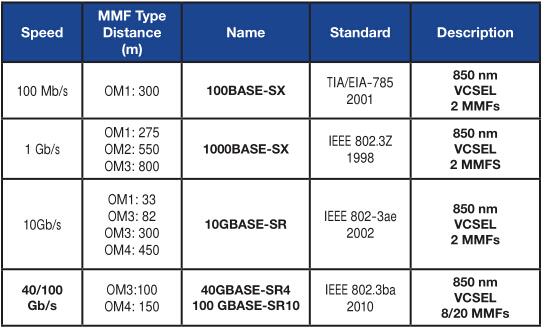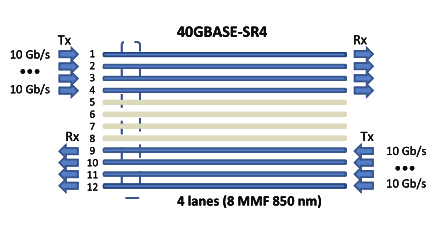With
the increasing network bandwidth to meet the global IP traffic demand,
there will be a need to upgrade to 40G Ethernet links for switch to
server and storage area network connections in data centers. And the
biggest market for 40G Ethernet (40 GbE) is in data centers for
interconnection links with servers and storage area networks. So this
article will talk about migration strategy for 40G Ethernet over
multimode fiber.
40G Ethernet Standard
IEEE
published the IEEE 802.3ba standard for 40 Gigabit Ethernet in June
2010. The following table illustrates the capabilities of different
grades of multimode fibers (OM1, OM2, OM3
and OM4) to support different Ethernet applications. Only the laser
optimized multimode fibers OM3 and OM4 are capable of supporting 40G
Ethernet. The cabling requirements for 40GBASE-SR4 will be focused and
guidance on an effective migration strategy to transition form 10G to
40G will be provided.

40G Ethernet Over Multimode Fiber
40G
Ethernet over multimode fiber uses parallel optics at 10Gb/s per lane.
One lane uses 1 fiber for each direction of transmission. 40G requires 8
fibers. The concept of parallel transmission at 10 Gigabits per lane is
illustrated below. The minimum performance that is needed to support
40G over multimode fiber is OM3 fiber for a distance of 100 meters.
Cabling with OM4 fiber provides the capability to extend the reach up to 150 meters.

Media Dependent Interface (MDI)
The
MDI is the physical interface that connects the cabling media to the
network equipment. For multimode fiber, the media dependent interface is
the MPO adapter that meets the dimensional specifications of IEC
61754-7 interface 7-3. The corresponding MPO female plug on the optical
fiber cable uses a flat interface that meets the dimensional
specifications. 40 GbE uses the MPO connector interface at the MDI and
uses a 12 position MPO connector interface that aligns 12 fibers in a
single row. Four transmit fibers are used on one side and four receive
fibers are used on the opposite side of the MPO connector, for a total
of eight fibers. The middle four fiber positions are not used.
Migration Path From 10G to 40G for Multimode Fiber
Migrating
from 10G (that uses two fibers in either a SC Duplex or a LC Duplex
connector) to 40G will require a lot more fibers and a different type of
connector. The way that optical fiber cabling is deployed for 10G can
facilitate an easier migration path to 40G. An effective migration
strategy needs to provide a smooth transition to the higher Ethernet
speeds with minimum disruption and without wholesale replacement of
existing cabling and connectivity components.
Optical
fiber cabling is commonly deployed for backbone cabling in data centers
for switch to switch connections and also for horizontal cabling for
switch to server and storage area network connections. The use of
pre-terminated optical fiber cabling can facilitate the migration path
to 40G. A pre-terminated cable assembly containing 24 OM4 multimode
fibers with two 12-fiber MPO connectors at both ends plugs into the back
of a breakout cassette that splits the 24 fibers into 12 LC duplex
connectors at the front of the cassette. It is necessary to provide some
40G connections, either as a replacement of or as an addition to the
existing 10G connections.
The
first case: if upgrading from 10G to 40G, one or more of the LC duplex
cassette/cassettes can be replaced with 12 MPO adapters. The MPO
adapters are designed to fit in the same opening as the cassettes.
Fiberstore offers a high-density 18 MPO adapter
with the same overall physical dimensions as 12 MPO adapter. This is an
upgrade path from 10G to 40G that does not require any additional space
and reuses the same patch panels. For instance, the 12 LC duplex
cassettes could be replaced with either a 12 MPO or 18 MPO adapters as
needed.
The
second case: if it is required to add some 40G connections while
retaining the 10G connections, a high-density cassette containing 18 LC
duplex connections in the same space as a 12 LC duplex cassette would be
used. Three of the 12 duplex cassettes can be replaced with three 18 LC
Duplex cassettes, thus maintaining the 48 10G connections while freeing
space for either a 12 MPO or 18 MPO adapter providing up to 18
additional 40G connections. The requisite number of additional fiber
cable assemblies in multiples of 12 fibers are provided as needed.
Summary
Pre-terminated
optical fiber cabling provides a seamless migration path to 40 Gigabit
Ethernet using the same infrastructure by adding pre-terminated trunk
cable assemblies and MPO adapter frames as needed. The use of
Fiberstore’s pre-terminated cabling facilitates the migration to 40G
Ethernet from 10G Ethernet networks today.
Article source: www.fiberopticshare.com/40g-ethernet-migration-strategy-over-multimode-fiber.html
没有评论:
发表评论